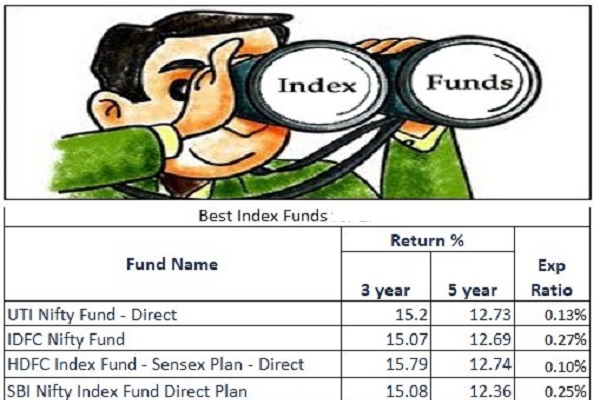As an investor, one of the best ways to make money and at the same time diversify your income portfolio is to invest in an index fund. It is less risky to invest in an index fund than to invest in an individual stock. The reason for this is that index funds usually hold hundreds of securities. With the aid of an index fund, you can spread the investment risk across the bonds and stocks of different individual companies.
So, today we will be looking at the 10 best Index Funds an investor can invest in and we list them as follows;
1. Fidelity Zero Large Cap Index (FNILX)
The Fidelity Zero Cap Index is part of the investment company’s foray into mutual funds without any expense ratio. This is an investment index fund that does not track the S&P 500 on an official basis.
It is important for an investor to note that the expense ratio of the Fidelity Zero Large Cap Index is zero percent. What this implies is that if an investor invests $10,000 on an annual basis, it will cost $0.
2. Shelton NASDAQ-100 Index Direct (NASDAQ)
The Shelton NASDAQ-100 index fund can be used by an investor to track the performance of the largest non-financial companies in the NASDQ-100 index. The NASDAQ -100 primarily includes companies with a tech orientation.
Every investor in the USA should know that the expense ratio of this mutual index fund is 0.5 percent, implying that for every $10,000 invested, a $50 cost would b incurred.
3. Invesco QCQ Trust ETF (QQQ)
The Invesco QCQ Trust ETF (QQQ), is another interesting index fund that can be used to track the performance of the largest non-financial companies that are in the NASDQ-100 index.
This is a mutual fund that started way back in the year 1999 and is managed by Invesco, a fund giant. The expense ratio of this index fund is 0.20 percent, implying that if you invest $10,000, it will cost the investor $20 on an annual basis.
4. Vanguard S&P 500 ETF (VOO)
As the name of this index fund implies, it is a fund that tracks the S&P 500 index. It is important to note that it is one of the largest funds with hundreds of billions in its fund. The Vanguard S&P 500 started way back in 2010 and was backed by
Vanguard. The annual cost of every $10,000 invested is $3. This is because the expense ratio of the Vanguard S&P 500 index fund is 0.03%.
5. SPDR S&P 500 ETF Trust (SPY)
This is one of the oldest index funds as it was founded in the year 1993. It helps kickstart ETF investing that is very popular in the financial markets today. The SPDR S&P 500 ETF is a popular ETF as it has hundreds of billions in the fund.
It is used to track the S&P 500, and it has an expense ratio of 0.09 percent. What this means for an investor, is that for every $10,000 invested, there would be a $9 cost incurred.
Picks by Editor:
10 Best Stocks For Long Term Investment
How To Invest In IRA Roth in 5 Simple Steps
10 Reasons to Invest in Cryptocurrency
6. Vanguard Russell 2000 ETF (VTWO)
This is an interesting index fund that can be used to track the Russell 2000 index. The Russell 2000 is a collection of 2000 of the smallest publicly traded companies in the united states of America. It has an expense ratio of 0.10 percent, and for every $10,000 that is invested, it will annually cost $10.
7. The iShares Core S&P 500 ETF (IVV)
The iShares Core S&P 500 ETF is an index fund that is sponsored by one of the largest fund companies known as BlackRock. It has been tracking the S&P 500 since the year of its founding in 2000. The expense ratio of this index fund is 0.03 percent, meaning that the cost of investing $10,000 on an annual basis will be $3.
8. Schwab S&P 500 Index Fund (SWPPX)
Schwab S&P 500 is an index fund that was founded way back in 1997. It is so named because it was sponsored by Charles Schwab, who was a well-respected name in the finance industry. The expense ratio of the Schwab S&P 500 index fund is 0.02 percent, meaning that it will annually cost $2 for every $10,000 that is invested.
9. Vanguard Total Stock Market ETF (VTI)
This is an index fund from Vanguard that is used to track the entirety of publicly traded stocks in the United States of America. It is an index fund that consists of small, medium, and large companies across all sectors. It kickstarted in the year 2001 and has an expense ratio of 0.03 percent. What this implies is that if an investor invested $10,000, it will cost him $3 on an annual basis.
10. SPDR Dow Jones Industrial Average ETF Trust (DIA)
This is an index fund that can be used to track a 30-stock index of large-cap stocks in the USA. It made its debut in the financial market way back in 1998 and since has tens of billions of dollars in management.
The expense ratio of the SPDR Dow Jones Industrial Average ETF trust is 0.16 percent, meaning that for every $10,000 that is invested, it will annually cost $16.










